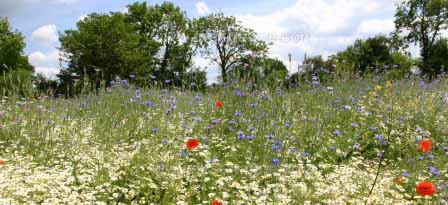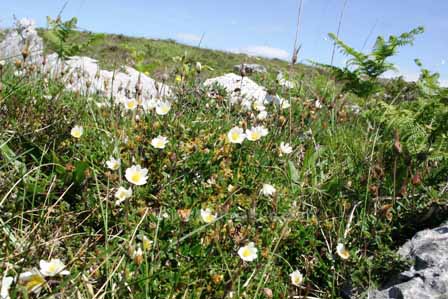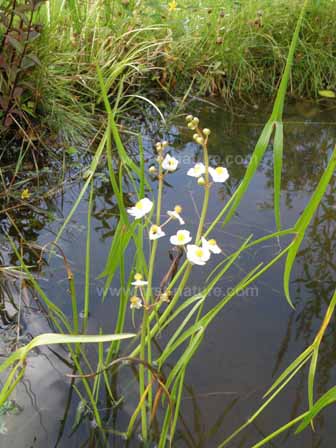Trees Birds Mammals Fish Amphibians Reptiles
Wild Algarve
Bookshop
Wildflower Conservation
Many wildflowers are in serious decline or endangered, and they need our protection. Just because a particular species appears to be numerous in one place does not necessarily mean that it is common elsewhere; you may even be looking at the last remaining plants of a species on the verge of extinction. The main threats to our wildflowers, other than the uncertainty of what may befall them as a result of climate change, are loss of habitat, intensive agricultural practice with its excessive use of herbicides and insecticides, and housing and industrial development.

A wildflower meadow is a wonderful sight
Plants are also threatened as a result of people picking their flowers or even digging them up in the hope of successfully transplanting them to gardens or other locations. Many species, wild orchids in particular, are dependent for their survival on a relationship with specific fungi in the soil where they occur and, as a result, they are very likely to die when removed and planted elsewhere. Please leave the flowers for others, and future generations, to enjoy. Taking photographs in a way that does not damage the surrounding soil and habitat of the wildflowers is a far better way of enjoying them once you have left the site where they are growing.
UK Statutory Conservation Organisations that care for Wildflowers in the UK
Natural England (NE) is the national authority charged by government with conserving and enhancing the natural environment in England, for its intrinsic value, the wellbeing and enjoyment of people and the economic prosperity that it brings.
In Wales Natural Resources Wales (NRW) is the national wildlife conservation authority and the Welsh Assembly Government's statutory adviser on sustaining natural beauty, wildlife and the opportunity for outdoor enjoyment in Wales.
Scottish Natural Heritage (SNH) is Scotland's national conservation agency; it's role is to look after the natural heritage, help people to enjoy and value it, and encourage people to use it sustainably.
Within the Department of Environment Northern Ireland, a wildlife and conservation service with remit broadly similar to those of EN, CCW and SNH operates.
Part of the statutory conservation agencies' remit is to ensure the survival and healthy population status of species and their habitats on National Nature Reserves and SSSIs (Sites of Special Scientific Interest). Some SSSIs are on private land without the right of general access; others are publicly accessible. In order to carry out this vital role the conservation agencies require proper funding, and in recent years budget cuts have made things much more difficult.
We are also fortunate to have a strong Wildlife Trust movement in the UK, and their wardens and volunteers, sometimes working with statutory conservation agency staff, protect our nature reserves and wildlife habitats. The Wildlife Trusts are mainly dependent on our support, both financial and in terms of volunteer effort, to carry out their work.
Other organisations that contribute to the protection of wildflower sites and reserves are Plantlife (www.plantlife.org); the National Trust (www.nationaltrust.org.uk); and the Royal Society for the Protection of Birds (www.rspb.org.uk) which has many reserves that are rich in wildflowers as well as birds.
Special sites
There are many famous places and special sites that are particularly rich in wildflowers - for example The Burren in Ireland's County Clare, and the Lot Valley in southern France.

Mountain Avens on The Burren, in Ireland
But here in the UK we also have many exceptionally rich nature reserves that we can recommend for trips and excursions, and so we are featuring several of these (for example Newborough Warren, on Anglesey) on our Great Sites pages. Some of these places are famous and given special protection by statutory conservation designations, either because of the diversity and number of species to be found there or because they are sites on which seriously endangered species of wildflowers can still be found. In the latter case many of these rare species are the subject of special monitoring and conservation measures.
Growing your own wildflowers
If you would like to try growing some of the beautiful wildflowers that you see in the countryside, you can buy seeds for many of them. Nurseries and garden centres also sell well-developed plants that have a good chance of survival in gardens - particularly those that contain the kind of habitat in which the flowers thrive in the wild.

Arrowhead blooming in the margin of a garden pond
For example, it is often quite easy to persuade nursery-grown wetland plants to grow in the margins of garden ponds or in excessively wet patches of grass that cannot easily be used for other purposes. In the particular case of wild orchids there are a few nurseries that specialise in growing the species most likely to survive garden cultivation. Always check that the nursery you are using is obtaining its seeds and plants in such a way that they are not depleting precious wild populations, in particular of endangered and protected species. As in every other industry there are some unscrupulous operators, and they can be unwittingly aided in their destructive work by our innocent desire to safeguard the future of wildflowers by growing them in the protected environment of our own gardens.
Sue Parker's latest ebook is a revised and enlarged edition of Wild Orchids in The Burren. Full details here...
Buy it for just £5.95 on Amazon...
Sue Parker's new ebook is a comprehensive and fully revised edition of her acclaimed field guide to the Wild Orchids of Wales. Full details here...
Buy it for just £5.95 on Amazon...
Please Help Us: If you have found this information interesting and useful, please consider helping to keep First Nature online by making a small donation towards the web hosting and internet costs.
Any donations over and above the essential running costs will help support the conservation work of Plantlife, the Rivers Trust and charitable botanic gardens - as do author royalties and publisher proceeds from books by Pat and Sue.